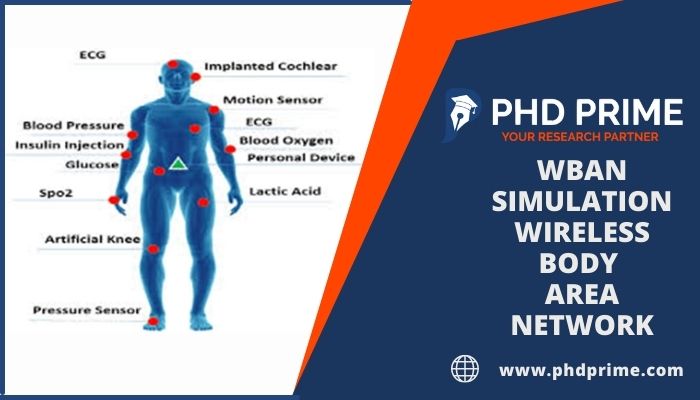A Wireless Body Area Network (WBAN) is a network consisting of physiological sensors which are placed in/on-body of the human. From this article, you can get information about the WBAN Simulation and their supporting communication technologies!!!
The main objective of this network is to continuously monitor a health condition. And, it is also popularly known as following names,
- Body Sensor Network (BSN)
- Medical Body Area Network (MBAN)

In other words, WBAN is represented as the network of a huge number of wearable devices. Further, it is classified into two kinds as extra-body and intra body communications which is useful for developing different types of medical applications. Some of them are given below,
Applications of WBAN
- Remote Control of Medical Devices
- Smart Patient Health Observation
- Web-based Emergency Tele-medicine Services
- Ambient Assisted Living (AAL) Platform for Healthcare system
- Wearable WBAN
- Military Defense Applications
- Wearable Device-based Remote Health Monitoring
- Monitoring and Diagnosis Application for Asthma / Sleep Staging
- Non-Medical
- Gaming and Emergency Applications
- Real-Time Electronic Records Streaming
- Implant WBAN
- Real-time Cancer Detection and Prediction
- Cardiovascular Disorder Risk analysis
In real-world scenarios, the footprints of WBAN Simulation are found everywhere in a different forms of real-time and non-real-time applications. For your reference, we have classified the applications into the following types. And, they are on-body (non-medical and medical) and off-body applications.
MAJOR APPLICATION TYPE OF WBAN
- On-Body Non-Medical Application
- Social Network Service
- Quality of Service (Latency-Sensitive)
- Power Usage – Minimum
- Bit Rate- Greater than 200 Kbps
- Observing Forgotten Things
- Quality of Service (Latency-Sensitive)
- Power Usage – Minimum
- Bit Rate- 256 Kbps
- Social Network Service
- On-Body Medical Application
- Blood Pressure (BP)
- Quality of Service (Latency-Sensitive)
- Power Usage- Maximum
- Bit Rate- Lesser than 10
- Oxygen Saturation (SpO2)
- Quality of Service (Latency-Sensitive)
- Power Usage- Minimum
- Bit Rate- 32Kbps
- Electrocardiogram (ECG)
- Quality of Service (Latency-Sensitive)
- Power Usage- Minimum
- Bit Rate- 3Kbps
- Blood Pressure (BP)
- In-body Application
- Pacemaker
- Quality of Service (Latency-Sensitive)
- Power Usage- Minimum
- Bit Rate- Few Kbps
- Capsule Endoscopy
- Quality of Service (Latency-Sensitive)
- Power Usage- Minimum
- Bit Rate- Greater than 2 Mbps
- Glucose Biosensor
- Quality of Service (Latency-Sensitive)
- Power Usage- Ultra-low
- Bit Rate- Few Kbps
- Pacemaker
Further, we have also listed the important research areas that work based on the WBAN Simulation. Along with this, we have also mentioned their corresponding major concepts involved in WBAN research.
Three Key Areas in WBAN
- Wearable Physical Body Monitoring
- Establish interaction via intelligent mechanisms
- Observe the human health state through wearable sensors
- Remote Patient Intensive Care Monitoring
- Applicable in both outdoor and indoor environment
- Screen the patient health from long-range and short-range communication
- Ambient Assisted Living (AAL) Aid
- Implant sensor in/off the patient’s body at home location
- Home and elderly care assistance
Now, we can see the communication technologies that make complex WBAN simulation possible from all aspects. For each technology, we have included the respective data rate, frequency, network topology, coverage, and modulation.
Communication Technologies of WBAN Simulation
- ZigBee (IEEE 802.15.4)
- Data Transfer Rate – 250 Kbps, 40 Kbps, and 20 Kbps
- Frequency – 915 MHz, 868 MHz, and 2.4 GHz ISM
- Network Structure – Mesh, Cluster-tree, and Star
- Communication Range – 10 to 100 m (on-body only)
- Modulation Type
- Binary Phase Shift Keying (BPSK) (+Amplitude Shift Keying)
- Offset-Quadrature Phase-Shift Keying (O-QPSK)
- Bluetooth V3.0 + High Speed (HS)
- Data Transfer Rate – 3 to 24 Mbps
- Frequency – 5 GHz and 2.4 GHz ISM
- Network Topology – Star
- Communication Range – 10m (on-body only)
- Modulation Type – Gaussian Frequency-Shift Keying (GFSK)
- Near Field Communication (NFC)
- Data Transfer Rate – 106,212,424 Kbps
- Frequency – 13.56 MHz
- Network Structure – Peer-to-Peer (P2P)
- Communication Range – Less than 20 cm
- Modulation Type
- Amplitude Shift Keying (ASK)
- Bluetooth V.2 + Enhanced Data Rate (EDR)
- Data Transfer Rate – 3 Mbps
- Frequency – 2.4 GHz ISM
- Network Structure – Star
- Communication Range – 10 to 100 m (on-body only)
- Modulation Type
- 8- Differential QPSK (8-DQPSK)
- π/4DQPSK
- Phase-Shift Keying (PSK)
- Gaussian Frequency-Shift Keying (GFSK)
- Z-wave
- Data Transfer Rate – 9.6 Kbps
- Frequency – 900 MHz ISM
- Network Structure – Mesh
- Communication Range – 30 m
- Modulation Type
- Frequency-Shift Keying (FSK)
- Binary Phase Shift Keying (BPSK)
- Bluetooth V4.0 + Low-End Extension (LEE)
- Data Transfer Rate – 1Mbps
- Frequency – 2.4 GHZ ISM
- Network Structure – Star
- Communication Range – 10m (on-body only)
- Modulation Type – Gaussian Frequency-Shift Keying (GFSK)
- Ultra-Wideband (UWB)
- Data Transfer Rate – 110 to 480Mbps
- Frequency – 3.1 to 10.6 GHz
- Network Structure – Star
- Communication Range – 5 to 10 m (on-body only)
- Modulation Type
- Direct Sequence Ultra-Wideband (DS-UWB)
- Quadrature Phase Shift Keying (QPSK)
- Orthogonal Frequency Division Multiplexing (OFDM)
- Binary Phase Shift Keying (BPSK)
- Bluetooth V.1 802.15.1
- Data Transfer Rate – 780 Kbps
- Frequency – 2.4 GHz ISM
- Network Structure – Star
- Communication Range – 10 to 150 m (on-body only)
- Modulation Type – Gaussian Frequency-Shift Keying (GFSK)
- ANT Protocol
- Data Transfer Rate – 1 Mbps
- Frequency – 2.4 GHz ISM
- Network Structure – Tree, Star, Peer-to-Peer (P2P) and Mesh
- Communication Range – 30 m (on-body only)
- Modulation Type
- Gaussian Frequency-Shift Keying (GFSK)
- RuBee (IEEE 1902.1)
- Data Transfer Rate – 9.6 Kbps
- Frequency – 131KHz
- Network Structure – Peer-to-Peer (P2P)
- Communication Range – 30m
- Modulation Type
- Binary Phase Shift Keying (BPSK)
- Bayesian Model Calibration (BMC)
- Amplitude Shift Keying (ASK)
- RFID (ISO/IEC 18000-6)
- Data Transfer Rate – 10 to 100 Kbps
- Frequency – 860 to 960MHz
- Network Structure – Peer-to-Peer (P2P)
- Communication Range – 1 to 100 m
- Modulation Type
- Phase-Shift Keying (PSK)
- Amplitude Shift Keying (ASK)
- Frequency-Shift Keying (FSK)
In addition, our developers have specified the list of vital techniques and procedures used for WBAN. Further, it comprises the need for an algorithm and the advantage of implementing that algorithm in WBAN projects.
WBAN Algorithms
- Cuckoo Search-based
- Purpose – Adaptive Band Selection
- Merits
- Optimal Relay Node Assignment
- Artificial Bee Colony
- Purpose – UnconstrainedData Transmission
- Merits
- Energy Consumption (Low)
- Reliability (High)
- Energy-Aware Opportunistic Routing
- Purpose – Load balancing
- Merits
- Network Load (low)
- Overhead (low)
- Cost and Energy-Aware Routing Protocol
- Purpose – Optimal Route Path Selection
- Merits
- Power-Efficient Routing
- Reliability and Throughput (High)
- Particle Swarm Optimization (PSO)
- Purpose – Optimized Solution for Computational Problem
- Merits
- Packet Transmission Success Rate (High)
- Specific Absorption Rate (Low)
- Genetic Ant Colony
- Purpose – Relay Node Selection
- Merits
- Energy Consumption (Low)
- Residual Energy (Low)
- Particle Swarm Optimization-Genetic
- Purpose – Workflow Scheduling Optimization
- Merits
- Lifetime (High)
- Mathematical Model for Linear Programming (LP)
- Purpose – Relay Node Selection
- Merits
- Network Stability Lifetime (High)
- Node Lifespan (High)
So far, we have discussed research-oriented information. Now, we can see the development of WBAN Simulation Projects. When we discuss code execution, it is important to know the available implementation tools and technologies for WBAN applications. So, here we have itemized the major WBAN simulators that are sure to yield the best results.
WBAN Simulation Tools
- MoBAN
- Support extensive range of WBAN real and non-real applications
- Work as the mobility model to assess intra/extra WBAN services
- The sensor has dynamic mobility characteristics which move over entire ambient environment
- Matlab
- Used to analyze the WBAN for examining the deployed sensors, signal path loss and strength and path loss
- Due to the increased number of wireless body area network (WBAN) applications, the antenna features interpretation has become very essential in human body monitoring
- QualNet
- Well-suited for the network-centric system
- Enable to build, test and deploy the system model
- Used to replicate the realistic network
- Assure to give long-lasting maintenance
- OPNET 14.5 Modeler
- Integrate with technologies like cloud, Hadoop, etc., and tools like OMNeT++, NS3, etc.
- Inspect the challenges related to the WBAN design, resource utilization, and MAC protocol design
- Also, analyze the efficiency of different WBAN approaches for system architecture
- Simulate WBAN applications and services using model-based architecture. For instance: The health-care system
- OMNeT++ with Castalia
- Mimic the real scenario through access network which establishes communication among human body and network sensors
- Place the physiological sensors on/off the body
- Simple to assess the network efficiency
- Used in both BAN and WSN for research purposes
- Include important characteristics as follows,
- PHY and MAC layer protocol modeling
- Spatial and temporal path loss variation
- Support large parametric simulation with accurate results
- Fine-grained RSSI and CSI computation
- NS2 and also NS3
- Support WBAN which is connected by wearable devices
- Launch interaction through different communication technologies
- Share data between devices and the human body. In the case of abnormality, notify the healthcare center or doctors
- The modules supported in IEEE 802.15.6 protocol standard are given as follows,
- #include “ns3/mobility-module.h”
- “ns3/core-module.h”
- “ns3/wifi-module.h”
- “ns3/simulator-module.h”
- “ns3/helper-module.h”
- “ns3/node-module.h”
- OMNEST
- Used for research need which is developed from OMNeT ++
- Support WBAN and WSN applications
- Widely used in both academic and research application development
Overall, the selection of development tools is equally important to the selection of research notions. So, our experts will give you perfect assistance in both these sections. Below, we have specified some important research challenges that give the best research topic for your study.
Research Ideas in WBAN
- Efficient Decentralized Resource Distribution
- Adaptive Network Topology Design
- Analysis of Body Shadowing Effect
- Power Aware-Wearable Computing Applications
- Interference Prevention and Mitigation Techniques
Simulation Parameters of WBAN
- Antenna – Dipole
- Walking velocity – 1 m/s
- Sampling rate – 50 Hz
- Software – Poser and Sim4Lite
- Human model – Duke Model (weight 70.2kg and height 1.77m)
- Off-body node location – 2.65 m high
- Frequency – 2.45 GHz
- Walking model – Thalmann model
- Antenna Isolation – -5mm
- On-body node locations – right thigh, right ear, right hand, left chest
To sum up, we ensure you that we will be with you from interested area identification to research implementation of wban simulation. Additionally, we also support you in paper and thesis writing through our native technical writer team. So, communicate with us to avail all these top-quality services from one place.





















